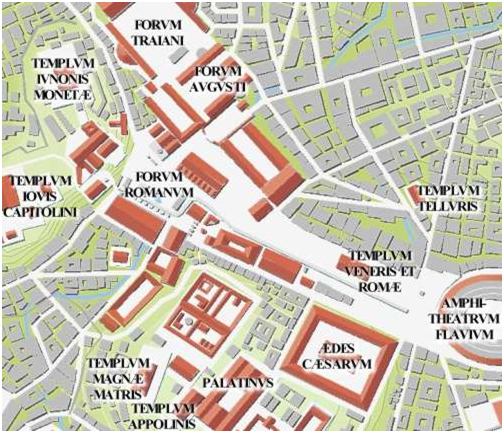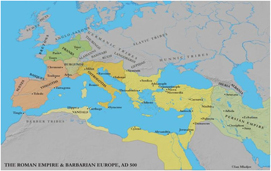During the reign of the so-called “Five Good Emperors” (96 – 180 AD) the Empire reached its territorial, economic and cultural zenith. The state was secure from both internal and external threats. With conquest of Darcia (King Darius of Darcia), during the reign of Trajan (98 – 117 AD), the Empire attained its maximum territorial size – 2.5 million sq. mi. and 56 million in population. (Get Hyperlink to PowerPoint mapping or URL).
Trajan (98-117), Commander of the Armies on the German Frontier became Emperor. He conquered Armenia, Parthia, Mesopatania, the great city of Susa to attain the greatest expanse of the Imperial Roman Empire. Hadrian (117-138) gave up Mesopatania concluding he did not have the resources to defend such an extensive frontier under strong tribal attacks. He did crush a major Jewish uprising in Judea (132-135) led by Simon Kokaba. Commodus (180-192) after assassination attempt ruled poorly with mental illness.
The period 193 – 235 AD was dominated by the Septimius of the Severan dynasty (Septimus Severus 193-211 AD, Caracalla 211-217, Macrinus 217-218, Elagabalus 218-222, Alexander Severuks 222-235)
Septimus was a generally successful ruler. He broadened the power base of the imperial administration throughout the empire. Caracalla extended full Roman citizenship to all free inhabitants of the empire. In the latter part of the Dynasty, the power of the Senate was revived by fiscal reforms. Alexander’s inability to control the Army led to its rebelling and his assassination in 235. His death ushered in a subsequent period of soldier-emperors interchanges and a half century of civil wars. Pax Romana which started at the death of Oxctavius Augusta, ended after about 200 years.
The inconsistent leadership among its rulers coupled with the increasing political and military intrusions by the powerful Praetorian Guard yielded a steady stream of crises. This latter interference was directly traceable to the inadequacies of the imperial rulers. Lack of strong, purposeful imperial leadership led to long period of slow internal dissolution. In the 3rd century, the Empire underwent military, political and economic crises and began its gradual decline. Inadequate assessment and strategies for coping with the increasing frequency of powerful, external invasions were so rampant that the period became known as the “Crisis of the Third Century.” A major contributor to this chaos was implanted during the reign of Octavius Agustus (23 AD) when he, as a well intended and planned approach, wanted to avoid the appearance of “Emperor,” so detested by the plebians, that he intentionally made no provisions for his and others succession.
Between 235-284, no fewer than 25 different Emporers ruled Rome (the soldier-emperor changes). All but two of these Emporers were either murdered or killed in battle. The period ended with the accession of Diocletian. Diocletian solved many of the acute problems. However, the core problems would remain and cause eventual destruction of the Western Roman Empire.
The crisis was ended by the more competent rule of Diocletian (284 – 301 AD) who in 293 AD, to achieve a feasible form of administration divided the Empire into Eastern and Western Empires and formed a Tetrarchy of two co-emperors and their two junior officers. In 330 AD, Emperor Constantine (305–363 AD) firmly set Byantium as the capital of the Eastern Roman Empire (later to be known as the Byzantian Empire) and named its capital as Constantinople. He similarly set a Western Roman Empire in 395 AD with Rome as its capital. Constantinus emerged in 353 AD as the sole Emperor of the entire Empire. Constantinus order his Caesar, Julian, successful against the German tribes and the Alamanni in the west, to transfer his Legions to the Eastern Empire to help against Shapur II of Persia. The order led to an insurrection. The timely death of Constantinus avoided another civil war!
Julian died of mortal wounds in 363 AD and was succeeded by an obscure officer Jovian as Emperor. He ceded the territories won from the Persians by Trajan. He rejected the paganism of Julian and restored the rights of Christians. He died 364 AD.
The Valentinian Dynasty (364-392AD). Valentinian choose Valens as his co-ruler. The two Augusti ruled: Valentinian administered the Western Roman Empire, while Valens took control over the Eastern Empire. Valens seeking glory for himself rushed into battle. Valens was crushingly defeated at Adrianople 378 AD. Valens was killed in the battle. The death of Valens left Gratian and Valentinian II as the two sole Augusti. Gratian was now responsible for the entire Empire. He choose Theodosius I as Augustus of the Eastern Roman Empire. This would prove to be a deciding point in the Empire history. Gratian became more unpopular. Spanish Celt General Maximus rebelling against Gratian invaded Gaul. Gratian fled to Lugunum (Lyon) where he was assassinated in 383 AD.
Maximus soon entered into negotiations with Valentinian II as the senior Augustus. The first years the Alps would serve as the borders between the territories of the two rival Emperiors. Maximus controlled Britain, Gaul, Hispania and Africa. The end of the year, found the Empire having five Augusti (Valentinian II, Theodosius I, Arcadius, Magnus Maximus and Flavius Victor) with relations between them to be determined. In 386 AD, Maximus tired of the Valentinian’s opposition, he crossed the Alps and threatened Milan. Theodosius stepped in and defeated Maximus who was executed in 388 AD.
Magister militum Arbogas was sent to Trier with orders to kill Flavius Victor. Valentinian II was murdered in 392 AD. Arbogast appointed Eugenius as Emperor, but Theodosius refused to recognize Eugenius and invaded the West killing Arbogast and Eugenius at the Battle of Friidus thus uniting the entire Roman Empire under his rule. Theodosius would be the last Emperor to rule over the entire Empire. On his death 395 AD, Theodosius gave the two halves of the Empire to his sons Aradius (East) with its capital at Constantinople and Honorius (West), its capital at Milan. After 395 AD, the Emperors of the West were mainly figureheads directed by military strongmen.
In 475 AD, the Magister Orestes revolted and made his son Romulus Augustus the Roman emperor. Romulus was not recognized by the Eastern Emperor Zeno so was a usurper. Romulus Augustus is often known as the last Western Roman Emperor. In 476, Orestes refused the request of Germanic mercenaries in his service for lands in Italy. The dissatisfied mercenaries, including the Heruli revolted. The revolt was led by the Germanic chieftain Odoacer. Odoacer and his men captured and executed Orestes. Romulus Augustus was deposed and Odoacer quickly conquered the remaining provinces of Italy. The war ended with Theodoric the Great King of the Ostrogoths conquering Italy under the authority of Zeno, Emperor of the Eastern Roman Empire.
The year 476 is generally accepted as the formal end of the Western Empire.
During the course of the next 50 years, following Commadus (180 – 192 AD), Rome would have no less than 26 different rulers in comparison to 18 confirmed Princeps over the Empire’s first two centuries. Never again would Rome benefit from rulers who had the foresight to understand the stability provided by selective succession. But rather in abandonment, the rulers allowed personal and dynastic ambition to play its erratic role in a clearly disintegrating decline of the Empire.
Under this inconsistent guidance, poorly managed military recruitment was shifted to the border provinces and gradually, became a policy of hiring “barbarian mercenaries”. The Legions eventually were reconfigured from an army of conquest and economic plunder to a standing army of border guards.
Structural problems began to be evidenced within the Empire. The mass citizenships granted and incorporated by Emperor Caracalla in 212 AD minimized the incentives to join the Legions. In the past, there had been strong attractions to join the Legions when these units were the main source for revenues (plunder), resources (territorial gains) and protection against pillage and death (invasions). Now the army was an increasing liability. Many of the neighboring, less affluent tribes could see this.
Lacking sufficient manpower and resources, the Western Roman Empire was constantly and increasingly being harassed by the Barbarian tribes (put hyperlink). In the 4th century, the westwood migration of the Huns (Germanic) caused the Visigoths (Gallic) to move into the territory of the Roman Empire. In 410 AD, the Visigoth under Alaric sacked the city of Rome. The Vandals invaded the Roman provinces of Gaul, Spain and North Africa.
In 455 AD the Germanic Chief Odoacer forced the last Roman Emperor of the West Empire, Romulus Augustus, to abdicate. Having lasted longer than almost all others Empires, after 1200 years the rule of Rome in West came to an end.


AFTER 1200 YEARS THE RULE OF ROME IN THE WEST COMES TO AN END
|

